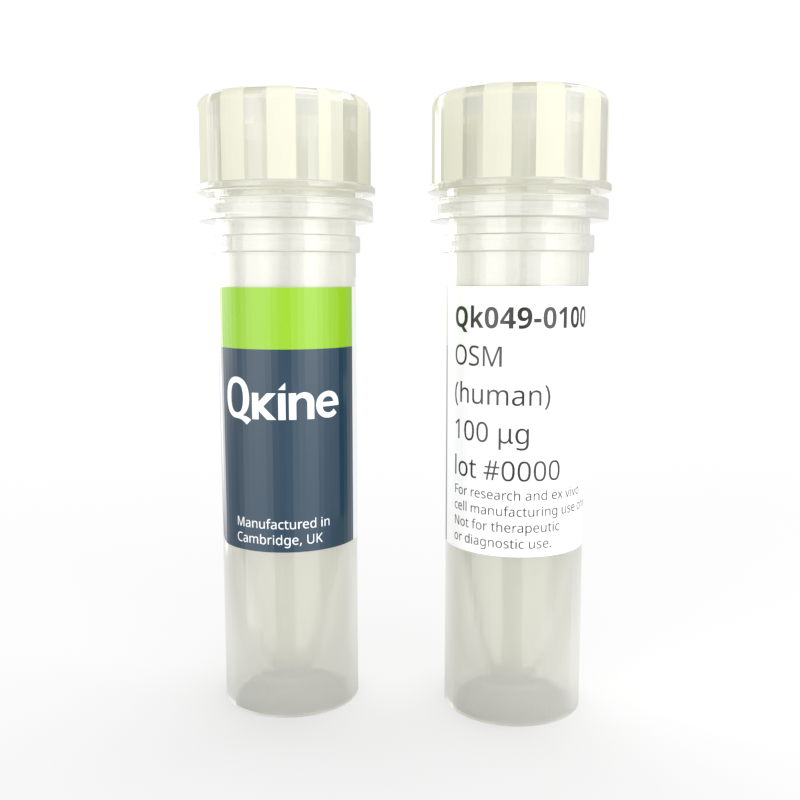Recombinant human OSM protein
QK049
Brand: Qkine
Human OSM protein (oncostatin M) is used in the differentiation of human pluripotent stem cells into hepatocyte-like cells. OSM also plays roles in osteogenesis and neurogenesis, and is an important regulator of the hematopoietic stem cell niche in the bone marrow.
Qkine human oncostatin M protein is high purity and animal origin-free (AOF) and carrier-protein free for reproducible results.

Currency:
| Product name | Catalog number | Pack size | Price | Price (USD) | Price (GBP) | Price (EUR) |
|---|---|---|---|---|---|---|
| Recombinant human OSM protein, 25 µg | QK049-0025 | 25 µg | (select above) | $ 340.00 | £ 250.00 | € 292.00 |
| Recombinant human OSM protein, 50 µg | QK049-0050 | 50 µg | (select above) | $ 520.00 | £ 380.00 | € 444.00 |
| Recombinant human OSM protein, 100 µg | QK049-0100 | 100 µg | (select above) | $ 685.00 | £ 500.00 | € 584.00 |
| Recombinant human OSM protein, 500 µg | QK049-0500 | 500 µg | (select above) | $ 2775.00 | £ 2025.00 | € 2366.00 |
| Recombinant human OSM protein, 1000 µg | QK049-1000 | 1000 µg | (select above) | $ 4370.00 | £ 3190.00 | € 3726.00 |
Note: prices shown do not include shipping and handling charges.
Qkine company name and logo are the property of Qkine Ltd. UK.
Alternative protein names
Species reactivity
human
species similarity:
bovine – 60%
porcine – 68%
rat – 50%
mouse – 50%
NB: although the sequence identity is low, human OSM has been shown to be active on mouse ES cells
Frequently used together:
Summary
- High purity human OSM protein (Uniprot: P13725)
- 22 kDa
- >98%, by SDS-PAGE quantitative densitometry
- Expressed in E. coli
- Animal origin-free (AOF) and carrier protein-free
- Manufactured in our Cambridge, UK laboratories
- Lyophilized from acetonitrile, TFA
- Resuspend in sterile-filtered water at >50 µg/ml, add carrier protein if desired, prepare single use aliquots and store frozen at -20 °C (short-term) or -80 °C (long-term).
Featured applications
- Maturation of hepatoblasts into hepatocyte like cells
Bioactivity
OSM activity is determined using the Promega serum response element luciferase reporter assay (*) in transfected HEK293T cells. EC50 = 0.75 ng/ml (34 pM). Cells are treated in triplicate with a serial dilution of OSM for 6 hours. Firefly luciferase activity is measured and normalized to the control Renilla luciferase activity. Data from Qk049 lot #104336. *Promega pGL4.33[luc2P/SRE/Hygro] #E1340

Purity
OSM migrates as a single band at 20 kDa in non-reducing (NR) conditions and 22 kDa upon reduction (R). The slight band under the main band in the reduced sample is likely an artefact of the reduction protocol. No contaminating protein bands are visible. Purified recombinant protein (3 µg) was resolved using 15% w/v SDS-PAGE in reduced (+β-mercaptothanol, R) and non-reduced (NR) conditions and stained with Coomassie Brilliant Blue R250. Data from Qk049 batch #104336.

Further quality assays
- Mass spectrometry: single species with expected mass
- Analytical reversed-phase: single sharp peak
- Endotoxin: <0.005 EU/μg protein (below level of detection)
- Recovery from stock vial >95%
Protein background
Oncostatin M (OSM) is a 30 kDa secreted cytokine. OSM is a member of the Interleukin-6 family, which includes IL¬11, CNTF and Cardiotrophin-1. Human OSM is produced in cells as a 252 amino acid pre-pro-protein. The signal peptide and the C- terminal domain are proteolytically cleaved to generate the mature 195 aa form [1].
Cytokines of the IL6 family bind a common receptor subunit, gp130. Unlike other family members, OSM binds gp130 with low affinity and requires recruitment of either LIF R α or OSM R β to form the OSM receptor type I or OSM receptor type II respectively. OSM has many physiological roles and is used in several iPSC and ESC protocols. OSM has essential functions in inflammation, neuroprotection, hematopoiesis, metabolism, early development, tumorigenesis and epithelial cell growth [2].
Human OSM shares 45% aa sequence homology with mouse and rat OSM, 54% bovine and 62% porcine. There is evidence that human OSM is active on mouse cells. In stem cell applications, animal-free oncostatin M is used to promote maturation of hepatoblasts into hepatocyte-like cells for liver regenerative medicine research and drug and toxicology assay development [3-5]. Recent evidence suggests OSM can maintain naïve mouse embryonic stem cells in the absence of LIF, although the significance and general application of this observation is to be established [6]. OSM also has uses in cultured meat applications, hematopoietic stem cell differentiation and basic research.
Background references
- [1] West, Nathaniel R., Benjamin M. J. Owens, and Ahmed N. Hegazy. ‘The Oncostatin M-Stromal Cell Axis in Health and Disease’. Scandinavian Journal of Immunology 88, no. 3 (2018): e12694. https://doi.org/10.1111/sji.12694.
- Richards, Carl D. ‘The Enigmatic Cytokine Oncostatin M and Roles in Disease’. ISRN Inflammation 2013 (8 December 2013): e512103. https://doi.org/10.1155/2013/512103.
- Hannan, Nicholas R. F., Charis-Patricia Segeritz, Thomas Touboul, and Ludovic Vallier. ‘Production of Hepatocyte-like Cells from Human Pluripotent Stem Cells’. Nature Protocols 8, no. 2 (February 2013): 430–37. https://doi.org/10.1038/nprot.2012.153.
- Hay, David C., Debiao Zhao, Judy Fletcher, Zoë A. Hewitt, Doris McLean, Alai Urruticoechea-Uriguen, James R. Black, et al. ‘Efficient Differentiation of Hepatocytes from Human Embryonic Stem Cells Exhibiting Markers Recapitulating Liver Development in Vivo’. Stem Cells (Dayton, Ohio) 26, no. 4 (April 2008): 894–902. https://doi.org/10.1634/stemcells.2007-0718.
- Tan, Lay Shuen, Resilind Su Ern Chew, Natasha Hui Jin Ng, and Adrian Kee Keong Teo. ‘Protocol for the Generation of Pancreatic and Hepatic Progenitors from Human Pluripotent Stem Cells for Gene Regulatory Assays’. STAR Protocols 2, no. 2 (18 June 2021): 100471. https://doi.org/10.1016/j.xpro.2021.100471.
- Ye, Xiaoying, Chenglei Tian, Linlin Liu, Guofeng Feng, Kairang Jin, Haiying Wang, Jiyu Chen, and Lin Liu. ‘Oncostatin M Maintains Naïve Pluripotency of MESCs by Tetraploid Embryo Complementation (TEC) Assay’. Frontiers in Cell and Developmental Biology 9 (2021): 1341. https://doi.org/10.3389/fcell.2021.675411.